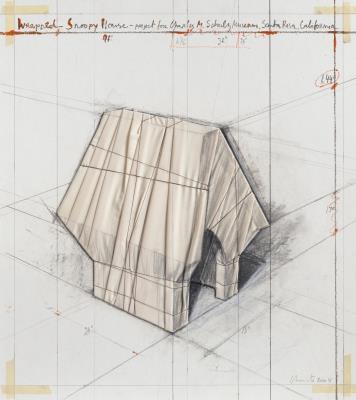克里斯托(Javacheff Christo,当代艺术I-
Christo * (Javacheff Christo) - Zeitgenössische Kunst I-
(Gabrovo, Bulgaria 1935–2020 New York)
Wrapped Snoopy House (Collage), 2004, signed, dated Christo 2004, cloth, threads, charcoal, pencil, color crayon, paint and adhesive tape on cardboard, 61.2 x 55 cm,
framed under plexiglass
The wrapped Snoopy House is registered in the Christo and Jeanne-Claude Archives, New York.
We are grateful to Jonathan Henery, Christo and Jeanne-Claude Archives, New York, for his scientific support in cataloguing the work.
Provenance:
Studio of the artist
Collection of the printer and fabricator Jack Lemon, Chicago
Private collection, 德国y
Literature:
This work is the prototype for the multiple, published by Schulz Museum, Santa Rosa, California see: Matthias Koddenberg, Jörg Schellmann: Christo and Jeanne-Claude: Prints and Objects. Catalogue Raisonné, p. 213, no 188
Charles M. Schulz (1922-2000) was the cartoonist of the globally successful comic series \"Peanuts\". The 美国 author and illustrator portrayed 美国 suburban life from the perspective of a group of children in the daily comic strips, which ran for decades. Peanuts was special in that it combined pointed wit with philosophical reflection.
Most of the comic strips focus on the main characters Charlie Brown and his dog Snoopy. Snoopy, the white dog with the black floppy ears, is now considered an integral part of our popular culture.
Snoopy lives in a kennel in Charlie Brown\'s garden. There, the beagle spends most of his time lying lazily on the roof of his hut, the so-called Snoopy Dog House, pondering his philosophical thoughts while waiting for his next meal.
In 1975, Charles M. Schulz met the packaging artists Jeanne-Claude and Christo at a discussion group in Colorado. The cartoonist then paid tribute to the artist couple by creating a Peanuts comic strip in 1978 in which Christo wraps Snoopy‘s House in fabric. In the comic strip, Snoopy wonders what Christo will cover next and finds his house wrapped at the end of the sequence. Christo returned the cartoonist\'s compliment by turning the comic image into reality decades later, designing a life-size, three-dimensional doghouse for the Charles M. Schulz Museum and wrapping it in tarpaulin, polyethylene and rope.
The work offered here is an original collage with real fabric wrapping, created by Christo in 1994 as a prototype for the later multiple. The multiple is number 188 in the catalogue raisonné.
This original work came from the estate of printer Jack Lemon, who founded his life\'s work, the Landfall Press, in Chicago in 1970. Lemon and his team printed lithographs by Christo, Philip Pearlstein and Sol LeWitt, among others.




![Zhar-Ptitsa/Jar-Ptitza [The Firebird]. Paris and Berlin: Russkoe Iskusstvo, August 1921-January 1926.](http://www.minghuafuzhi.com/2022/12/02140739959.jpg)

![A Short Discoverie Of the Coasts and Continent of America. London: [no printer], 1644.](http://www.minghuafuzhi.com/2022/12/02141009566.jpg)
![Liber pestilentialis de venenis epidemic. Das buch der vergift der pestilentz. [Strassburg]: Johann Grüninger, 19 August 1500.](http://www.minghuafuzhi.com/2022/12/02142342499.jpg)

